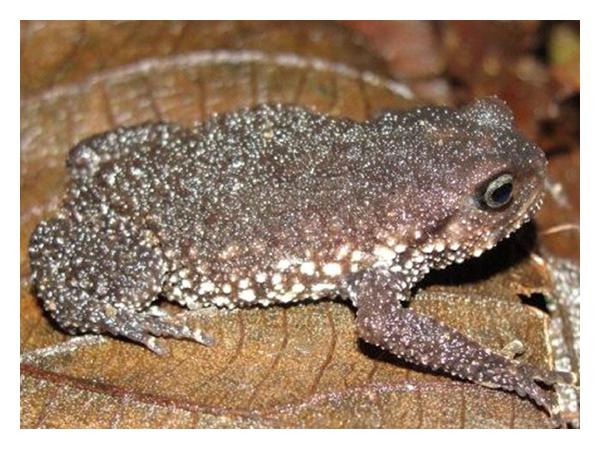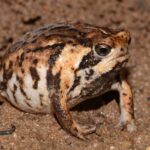- Callulina dawida: The Secretive Jewel of Africa’s Forests
- Taxonomy and Classification of the Taita Warty Frog
- Exploring the Natural Habitat: Where Does Callulina dawida Live?
- The Appearance and Physical Traits of Callulina dawida
- The Secretive Behaviors and Life Cycle of Callulina dawida
- Ecological Role: A Key Species of the Taita Forest Ecosystem
- Threats and Conservation: Preserving the Taita Warty Frog’s Future
- Cultural and Scientific Significance of Callulina dawida
- Conclusion: Celebrating and Preserving a Hidden Forest Gem
Callulina dawida: The Secretive Jewel of Africa’s Forests#
Nestled deep within the verdant, mist-laden highlands of East Africa, hidden amongst tangled roots and moist leaf litter, lives a secretive jewel of nature: the remarkable frog known as Callulina dawida. Commonly referred to as the Taita Warty Frog, this enigmatic amphibian thrives in seclusion, making its home in the cloud-covered mountains of southeastern Kenya. Although seldom encountering the eyes of casual explorers, this diminutive creature inspires fascination among scientists, conservationists, and nature enthusiasts alike, offering a window into the delicate balance of the tropical forest ecosystem.
At first glance, you might mistake Callulina dawida for just a small brownish lump among damp leaves. Yet closer observation reveals a creature infinitely more complex—the intricately textured skin resembling lichen-covered bark, eyes keenly attuned to its surroundings, and cryptic coloration perfectly adapted to its moss and leaf-filled habitat. Not only is Callulina dawida a zoological treasure, it’s a stark reminder of the subtle beauty and ecological significance hidden within the world’s less-explored corners.
Taxonomy and Classification of the Taita Warty Frog#
Belonging to the family Brevicipitidae, Callulina dawida is an essential member of a group characterized by distinctive morphology and ecology. Described formally by scientists Loader, Measey, de Sá & Malonza in 2009, it belongs to the genus Callulina, a small but fascinating group of East African frogs renowned for their unique adaptations and endemism.
Within the genus Callulina, a handful of closely related species are scattered across Tanzania and Kenya, each adapted to their distinctive montane environments. Yet, despite similarities, Callulina dawida stands apart, uniquely evolved to thrive within the microclimates of the Taita Hills. Isolation within mountainous islands of forest over millennia has shaped this species, giving rise to subtle genetic quirks that distinguish it clearly from its relatives.
Exploring the Natural Habitat: Where Does Callulina dawida Live?#
The home of Callulina dawida is as much part of its identity as its biology. This small amphibian is endemic to the Taita Hills, an island of lush Afromontane forests rising dramatically above the dusty savannahs in southeastern Kenya. Unlike the expansive jungles of larger forest ecosystems, the Taita Hills form a series of isolated peaks covered in misty woodlands, rich in biodiversity but separated from similar ecosystems by stretches of lower, drier lands.
Within this unique habitat, these frogs occupy very specialized niches characterized by moist, shaded undergrowth, organic humus layers, and thick leaf litter. Beneath the canopy of native evergreen trees, amidst moss-covered tree trunks and rotting logs, these animals find their ideal conditions—humidity levels consistent, temperatures mild, and protection from predators abundant.
A Humid Refuge: Microhabitats and Ecological Adaptations#
The adaptive prowess of Callulina dawida becomes evident through its affinity for microhabitats. It relies heavily on moisture levels maintained by this montane forest, using burrows under root masses, leaf-litter layers, and beneath mossy logs as daytime shelters. These conditions provide insulation against harsh temperature fluctuations and protection from daytime predators. The species’ life is so integrated into this specific habitat that small disturbances, whether through climate change or deforestation, can profoundly affect their survival.
The Appearance and Physical Traits of Callulina dawida#
A masterpiece of subtlety and adaptation, Callulina dawida may initially appear unimpressive due to its modest size and coloration. Adults usually measure just around 25–40 millimeters in length—a diminutive, rounded body perfectly suited for burrowing and hiding among decomposing leaf matter.
Their skin, displaying an earthy palette of browns, beige, and rusty reds, is profoundly textured with warty lumps and bumps. This intricate, rugged appearance not only gives this species its common name—the Taita Warty Frog—but also aids profoundly in camouflage. The bumpy skin mimics moss, fungi, and fallen leaves, perfectly concealing the frog from potential predators scanning leaf litter for movement or color anomalies.
Camouflage as Survival: survival through Mimicry#
Survival in an environment teeming with visual hunters requires subtlety—Callulina dawida embodies this principle with remarkable effectiveness. Its color variation, texture complexity, and cryptic habits help render it nearly invisible to eyes unaccustomed to its disguise. Quietly resting amidst the detritus, these frogs avoid the gaze of predators such as birds and small mammals, securing their continued survival through camouflage perfected over thousands of generations.
The Secretive Behaviors and Life Cycle of Callulina dawida#
As remarkably adapted as this species is in appearance and habitat preference, it equally fascinates specialists with its behavior and reproduction patterns. Primarily nocturnal, these frogs spend the daylight hours hidden from sight, emerging at nightfall to hunt tiny arthropods—ants, mites, springtails, and other miniature invertebrates abound in their nutritious diet.
Feeding Habits and Behavior Patterns#
Their hunting strategy relies on an ambush approach. Quietly waiting with stillness perfected through evolution, they patiently sit motionless, springing forward to capture passing prey with remarkable speed and accuracy. This efficient strategy conserves energy—a crucial adaptation providing evolutionary advantage in resource-scarce environments like forest floors.
Unique Breeding and Reproductive Strategies#
Perhaps the most fascinating aspect of Callulina dawida is their reproductive method. Unlike most frogs, they bypass traditional tadpole stages entirely. Eggs are laid terrestrially, often hidden among moist soil or decomposing leaf substrates—a safer alternative to water bodies that may harbor predators and parasites. Remarkably, the eggs undergo full development within their protective capsules, and juveniles hatch fully formed, miniaturized versions of their parents ready to begin their secretive life in the Taita Hills’ undergrowth.
Ecological Role: A Key Species of the Taita Forest Ecosystem#
Beyond its intrinsic value, Callulina dawida serves as a biological indicator of forest health. Their presence indicates balanced temperatures and moisture regimes crucial to the survival of many other organisms within the ecosystem. By occupying intermediate positions in local food webs—predators to insects yet prey to larger vertebrates—these frogs help maintain ecological equilibrium through their interactions.
As predators, they manage populations of small arthropods, limiting overabundant species capable of affecting forest plant life through excessive herbivory or plant-pathogen transmission. Conversely, their presence supports larger predators like birds and small mammals dependent upon a stable food base. Thus, their existence serves as an ecological linchpin, maintaining balance and highlighting ecological integrity within their native forests.
Threats and Conservation: Preserving the Taita Warty Frog’s Future#
Despite their incredible adaptation, evidence suggests Callulina dawida faces considerable threats. Currently classified as Critically Endangered (IUCN Red List), the species confronts habitat loss through agricultural encroachment, logging, climate change, and habitat fragmentation—all common threats facing biodiversity hotspots globally.
Conservation measures, including establishing protected areas and restoring degraded habitats, have been initiated. Local and international organizations collaborate to raise awareness, protect remaining habitats, and encourage sustainable living among communities sharing the region.
Cultural and Scientific Significance of Callulina dawida#
The Taita Hills have long held cultural significance for local communities, associated with traditional beliefs, myths, and folklore surrounding nature’s interconnectedness. Though specific cultural stories involving Callulina dawida directly might be scarce, the forest ecosystem it occupies symbolizes the rich biodiversity heritage of the Taita Hills. Scientifically, its discovery reinforced the importance of micro-endemic species as powerful indicators of evolutionary processes, environmental change, and ecological health.
Conclusion: Celebrating and Preserving a Hidden Forest Gem#
Callulina dawida, the secretive jewel of Africa’s forests, captures our attention not only because it exists but because it symbolizes nature’s incredible resilience and biodiversity potential despite adverse conditions. Protecting this small amphibian means safeguarding the whole ecosystem surrounding it and preserving the countless species sharing its precious home.
For those inspired by the wonder of hidden wildlife gems like the Taita Warty Frog, learning more about their ecology and supporting conservation can make a real difference. By protecting habitats and recognizing these cryptic treasures, we ensure the continued tapestry of life woven intricately in the hidden recesses of our world’s forests.








